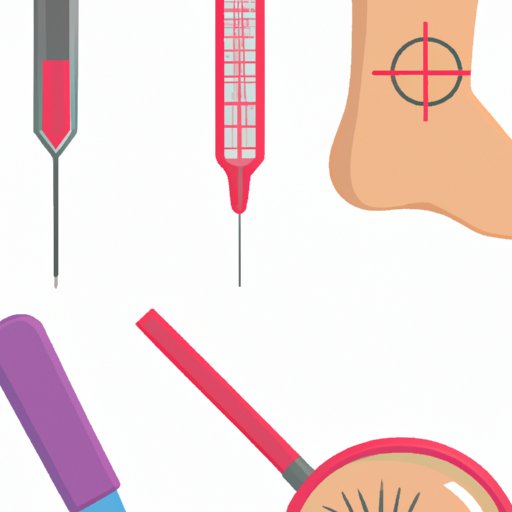
Introduction
Blood clots are a common health condition that can be dangerous if left untreated. They occur when blood forms a plug or clot inside a blood vessel, preventing normal blood flow. While blood clots can form in any part of the body, they are most commonly found in the legs, lungs, and brain. In this article, we’ll explore the symptoms, risk factors, diagnosis, treatment options, and prevention strategies for blood clots.
Symptoms and Warning Signs
There are several common symptoms and warning signs of blood clots to be aware of. These include:
- Swelling in one leg or arm
- Pain or tenderness in one leg or arm, which may become red or warm to the touch
- Sudden, severe headache or vision changes
- Shortness of breath or difficulty breathing
- Chest pain or discomfort that may worsen with deep breaths or coughing
- Coughing up blood
- Weakness or numbness in the face or limbs, particularly on one side of the body
It is important to note that the symptoms of a blood clot can differ depending on where the clot is located. For instance, if the clot is in your leg, you may experience swelling or warmth in that area, whereas a clot in your lungs may cause chest pain or shortness of breath. If you or someone you know is experiencing any of these symptoms, seek medical attention immediately.
Risk Factors
There are several risk factors that can increase your likelihood of developing a blood clot. These include:
- Having a family history of blood clots
- Being overweight or obese
- Being over the age of 60
- Sitting or standing in one position for long periods of time
- Smoking cigarettes
- Taking birth control pills or hormone replacement therapy
- Having a medical condition that affects blood clotting, such as cancer or heart disease
While some of these risk factors cannot be changed, there are certain lifestyle factors that can reduce your risk of developing a blood clot. These include maintaining a healthy weight, exercising regularly, and quitting smoking if you are a smoker.
Diagnosis
There are several tests and procedures your doctor may use to diagnose a blood clot. These include:
- Ultrasound imaging: This non-invasive test uses high-frequency sound waves to create images of the inside of your body, allowing your doctor to identify the presence of a blood clot.
- Blood tests: Your doctor may take blood samples to test for chemicals or markers that may indicate the presence of a blood clot.
- CT scan or MRI: These imaging tests create detailed images of your body to help your doctor determine the location and severity of a blood clot.
Once your doctor has diagnosed a blood clot, they can determine the best course of treatment.
Treatment Options
The treatment of a blood clot will depend on the location and severity of the clot. Common treatment options include:
- Blood thinners: These medications can help prevent the clot from growing and reduce the risk of new clots forming.
- Clot-busting medications: In some cases, your doctor may prescribe medication that can dissolve the blood clot.
- Surgery: In more severe cases, surgery may be necessary to remove the blood clot.
It is important to follow your doctor’s treatment plan closely to ensure a full recovery and prevent any complications. In some cases, the treatment of a blood clot may require ongoing care or monitoring.
Preventing Blood Clots
While some risk factors for blood clots cannot be changed, there are several preventative measures you can take to reduce your risk. These include:
- Maintaining a healthy weight
- Exercising regularly
- Quitting smoking
- Avoiding sitting or standing for long periods of time
- Wearing compression stockings when traveling or sitting for long periods of time
- Taking medication or supplements prescribed by your doctor to reduce your risk of blood clots
If you have a high risk of developing blood clots, your doctor may recommend preventative medication or lifestyle changes to help reduce your risk.
Conclusion
Blood clots are a common and potentially dangerous health condition. However, by being aware of the symptoms and risk factors, as well as taking preventative measures, you can significantly reduce your risk of developing a blood clot. If you suspect that you or someone you know may have a blood clot, seek medical attention immediately. Remember that early diagnosis and treatment can help prevent complications and ensure a full recovery.




